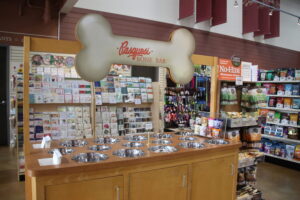
What’s Your Company’s DNA?
Being the master of understatement, let me state the obvious: managing a retail business in today’s competitive environment is not for the faint of heart! Not only are you battling other brick and mortar retailers and the online purveyors for customers, but you’re also fighting to hire and retain the best employees that can be a major asset in achieving your goals.
The questions of the day are: How do you connect with your target customer in such a way that they can relate to who you are, your values, and whether your brand is relevant to them?; and Can you motivate and lead your team so they truly support your values, goals, and the way you do business?
It’s said that your brand is a direct reflection of your values and how you position your company that establishes a set of expectations that the consumer can hopefully embrace. Too often, however, we start fabricating our brand and attempting to communicate it to the consumer before we internally build the foundation of identifying our core values, our vision and what we really want to accomplish with our company, and then communicating our brand message and market position.
While this process is generally driven by the owners or senior managers of a company, to be successful, it must get critical buy-in and support from the entire team. And when the employee team sees management putting these values into practice on a daily basis, they start to become believers — and their behaviors and actions become synched with management’s lead.
Over time, with repetition, it becomes engrained in how the company operates and acts as a guidepost for employee behavior and decision-making; it becomes part of the core culture or DNA of the company. And as the company culture gets reflected into operational execution, the consumer starts getting exposed to the culture, making it a key differentiator in a highly competitive marketplace.
How Strong is Your Corporate Culture?
To demonstrate how a strong corporate culture can drive brand image and operational execution, here are two great examples. First, let’s look at Disney Resorts. Pricy tickets? You bet! A major time investment to get the full experience? A minimum of three days. A wholesome family experience? Unmatched! And they earn a 70% customer return rate, a rate that most retailers and entertainment centers can only dream about.
How do they achieve this success? Sure, a new ride or attraction every year or so helps, but what really drives their success is the execution of the culture in operations, facilities and the way their team members relate with the public. It’s a laser-like focus on doing everything possible to deliver an outstanding guest experience. Everyone is on the same page and is guided by common values. They set very high expectations, and consistently exceed them.
But in addition to all of the highly visible things — costumed theme characters, rides, food courts, monorails, hotels, etc. — Disney spends a fortune to keep its parks clean, safe and comfortable; they recognize that their excellence sometimes means doing all you can to remain unnoticed. This is the essence of their culture; everything Disney does is focused on delivering the ultimate consumer-centric experience to their guests, their core culture.
Focus on the Consumer
As another example, I had the privilege of working as a senior merchandising/marketing exec at what was then, a small, regional mass marketer — Target — trying to compete with the two retail behemoths of the time, Kmart and Wal-Mart. Target operated under the culture of their parent company, Dayton Hudson Department Stores (now defunct), which greatly hindered its ability to carve out its own identity needed to effectively compete against the other big boxes.
Fortunately, senior management realized that, if they wanted the company to compete and grow, new thinking and direction was needed, and so began the era of Bob Ulrich as CEO.
One of his fist changes was shifting from an operational excellence focus to a consumer-centric focus; he achieved this by taking the entire senior management team to Disney’s university to learn what that took from the best of the business, and then started to re-shape the culture of the thousands of Target employees.
Bob’s next change was to start a focus on innovation and change as competitive advantages. He fostered a culture of always working on something new that could be brought to market quickly. Even today, many years after being part of that new culture, I still vividly recall three mantras that encapsulated that era at Target:
- “Fast, Fun and Friendly!” Provided a framework on how we wanted to treat each other and the guest.
- “Ready, Fire, Aim!” An understanding that being first to market is a competitive advantage; if you wait too long to iron out all the kinks in a new program before you roll it out, you’ll miss an opportunity period; get it 90% right, and you can adjust the other 10% on the fly after you launch it. In addition, this strategy encouraged continuous testing of new products and strategies, with the full knowledge that not all of them would work (but you’ll never know if you don’t try!).
- “Speed is Life.” A sense of urgency drove everything we did; there was no room for complacency if we wanted to achieve our lofty goals.
Leadership Matters
During the Ulrich era, Target’s growth was explosive, growing to become a national chain with outstanding financial results. And Bob was quick to note that it was the culture that existed that was hugely responsible for the results that were achieved.
Unfortunately, when Bob retired, he was replaced with a CEO whose management style was to “manage” the business rather than “lead it.” His vision for growth was pinned to a major expansion into Canada which was a dismal failure due to poor execution. And Target dragged its feet on developing an online platform, lagging their competitors. As a result, the financials — and the culture — rapidly deteriorated.
In 2014, Brian Cornell came in as CEO and re-started the process of change and innovation, with major investments in remodeling stores, creating a leading-edge online platform and omni-channel marketing and operations/fulfillment platform, with tremendous consumer (and Wall Street) acceptance. Target got its mojo back, the employees believed in what was happening, saw the results and the changed culture now helps drive continuous innovation and growth.
From your experience, you know what can be accomplished when your entire team works together, and when they do it consistently; the results are almost miraculous. Providing a framework that can guide their behaviors, actions and decision-making is essential to making this happen. And this framework is your DNA, the culture of your company.
So, what’s your company’s DNA?…


















 Videos
Videos





